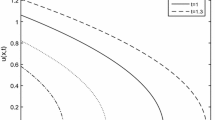Abstract
Non-integer-order derivatives have proven useful while modelling natural systems involving memory effects. In this article, we analyse the Maxey–Riley (M–R) equation that models the motion of a small particle in a non-uniform flow field. Fractional derivative arises naturally as a history term. We study the M–R equation in terms of fractional differential equations, a subject very well studied in recent times. This approach helps in gaining a deeper understanding of the underlying phenomenon. We observe solution curves having self-intersections, which is a novel feature of fractional-order dynamics.





















Similar content being viewed by others
Availability of data and material
Data sharing does not apply to this article as no datasets were generated or analysed during the current study.
Code Availability
Basic Mathematica commands were used to plot the solutions and can be provided by the corresponding author upon request.
References
Borzì A (2020) Modelling with ordinary differential equations: a comprehensive approach. Chapman and Hall, Oxon
Moghadas SM, Jaberi-Douraki M (2018) Mathematical modelling. Wiley, p 07030
Volterra V (1932) Theory of functionals and of integral and integro-differential equations. Bull Am Math Soc 38(1):623
Podlubny I (1998) Fractional differential equations: an introduction to fractional derivatives, fractional differential equations, to methods of their solution and some of their applications, vol 198. Academic Press, San Diego
Kobayashi MH, Coimbra CF (2005) On the stability of the Maxey–Riley equation in nonuniform linear flows. Phys Fluids 17(11):113301. https://doi.org/10.1063/1.2128254
Coimbra C, Rangel R (2000) Unsteady heat transfer in the harmonic heating of a dilute suspension of small particles. Int J Heat Mass Transf 43(18):3305–3316. https://doi.org/10.1016/S0017-9310(99)00381-6
Tarasov VE (2020) Mathematical economics: application of fractional calculus. Mathematics 8(5):660. https://doi.org/10.3390/math8050660
Bolster D, Benson DA, Singha K (2017) Upscaling chemical reactions in multicontinuum systems: when might time fractional equations work? Chaos Soliton Fract 102:414–425. https://doi.org/10.1016/j.chaos.2017.04.028
Ionescu C, Lopes A, Copot D et al (2017) The role of fractional calculus in modeling biological phenomena: a review. Commun Nonlinear Sci 51:141–159. https://doi.org/10.1016/j.cnsns.2017.04.001
Magin RL (2010) Fractional calculus models of complex dynamics in biological tissues. Comput Math Appl 59(5):1586–1593. https://doi.org/10.1016/j.camwa.2009.08.039
Daftardar-Gejji V (ed) (2019) Fractional calculus and fractional differential equations. Springer
Atangana A, Koca I (2017) Model of thin viscous fluid sheet flow within the scope of fractional calculus: fractional derivative with and no singular kernel. Fundam Inform 151(1–4):145–159. https://doi.org/10.3233/FI-2017-1484
Qayyum M, Ismail F, Sohail M et al (2021) Numerical exploration of thin film flow of mhd pseudo-plastic fluid in fractional space: utilization of fractional calculus approach. Open Phys 19(1):710–721. https://doi.org/10.1515/phys-2021-0081
Failla G, Zingales M (2020) Advanced materials modelling via fractional calculus: challenges and perspectives. Philosop Trans R Soc A 378(2172):20200050. https://doi.org/10.1098/rsta.2020.0050
Maxey MR, Riley JJ (1983) Equation of motion for a small rigid sphere in a nonuniform flow. Phys Fluids 26(4):883–889. https://doi.org/10.1063/1.864230
Stokes GG et al (1851) On the effect of the internal friction of fluids on the motion of pendulums. Trans Camb Philos Soc 9:8
Boussinesq J (1885) Sur la resistance quoppose un fluide indefini en repos, sans pesanteur, au mouvement varie d’une sphere solide qu’il mouille sur toute sa surface, quand les vitesses restent bien continues et assez faibles pour que leurs carres et produits soient negligiables. C R Acad Sc Paris 100:935–937
Basset AB (1887) On the motion of a sphere in a viscous liquid. Proc R Soc Lond Ser I 43:174–175
Oseen C (1927) Hydromechanik. Akademische, Leipzig
Coimbra C, L’esperance D, Lambert R et al (2004) An experimental study on stationary history effects in high-frequency stokes flows. J Fluid Mech 504:353–363. https://doi.org/10.1017/S002211200400789X
Farazmand M, Haller G (2015) The Maxey–Riley equation: existence, uniqueness and regularity of solutions. Nonlinear Anal Real World Appl 22:98–106. https://doi.org/10.1016/j.nonrwa.2014.08.002
Prasath SG, Vasan V, Govindarajan R (2019) Accurate solution method for the Maxey–Riley equation, and the effects of basset history. J Fluid Mech 868:428–460. https://doi.org/10.1017/jfm.2019.194
Matignon D (1996) Stability results for fractional differential equations with applications to control processing. Comput Eng Syst Appl 2:963–968
Kaslik E, Sivasundaram S (2012) Non-existence of periodic solutions in fractional-order dynamical systems and a remarkable difference between integer and fractional-order derivatives of periodic functions. Nonlinear Anal Real World Appl 13(3):1489–1497. https://doi.org/10.1016/j.nonrwa.2011.11.013
Deshpande A, Daftardar-Gejji V, Vellaisamy P (2019) Analysis of intersections of trajectories of systems of linear fractional differential equations. Chaos 29(1):13113. https://doi.org/10.1063/1.5052067
Bhalekar S, Patil M (2018) Singular points in the solution trajectories of fractional order dynamical systems. Chaos 28(11):113123. https://doi.org/10.1063/1.5054630
Dimovski I (1982) Convolutional calculus, publishing house of the Bulgarian academy of sciences. Sophia
Luchko Y, Gorenflo R (1999) An operational method for solving fractional differential equations with the caputo derivatives. Acta Math Vietnam 24(2):207–233
Kilbas AA, Srivastava HM, Trujillo JJ (2006) Theory and applications of fractional differential equations, vol 204. Elsevier, Amsterdam
Miller KS, Ross B (1993) An introduction to the fractional calculus and fractional differential equations. Wiley, Hoboken, New Jersey
Landau LD, Lifshitz EM (2013) Fluid mechanics: Landau and Lifshitz: course of theoretical physics, vol 6. Elsevier
Bhalekar S, Patil M (2019) Can we split fractional derivative while analyzing fractional differential equations? Commun Nonlinear Sci 76:12–24. https://doi.org/10.1016/j.cnsns.2019.04.009
Funding
The authors did not receive support from any organization for the submitted work.
Author information
Authors and Affiliations
Contributions
All authors contributed equally.
Corresponding author
Ethics declarations
Competing interests
The authors have no relevant financial or non-financial interests to disclose.
Rights and permissions
Springer Nature or its licensor (e.g. a society or other partner) holds exclusive rights to this article under a publishing agreement with the author(s) or other rightsholder(s); author self-archiving of the accepted manuscript version of this article is solely governed by the terms of such publishing agreement and applicable law.
About this article
Cite this article
Hegade, A., Daftardar-Gejji, V. & Bhalekar, S. Maxey–Riley equation: newer perspective. Int. J. Dynam. Control 12, 85–97 (2024). https://doi.org/10.1007/s40435-023-01268-5
Received:
Revised:
Accepted:
Published:
Issue Date:
DOI: https://doi.org/10.1007/s40435-023-01268-5




